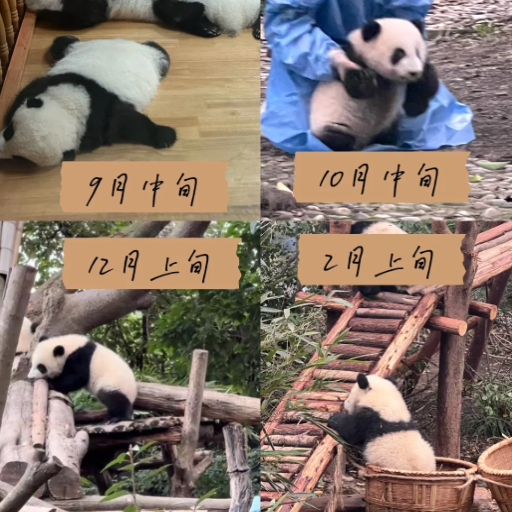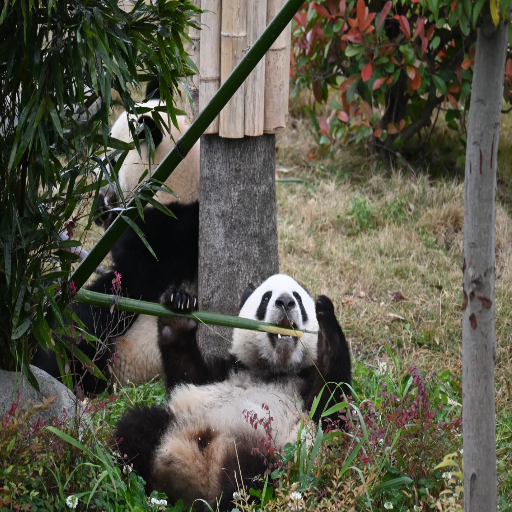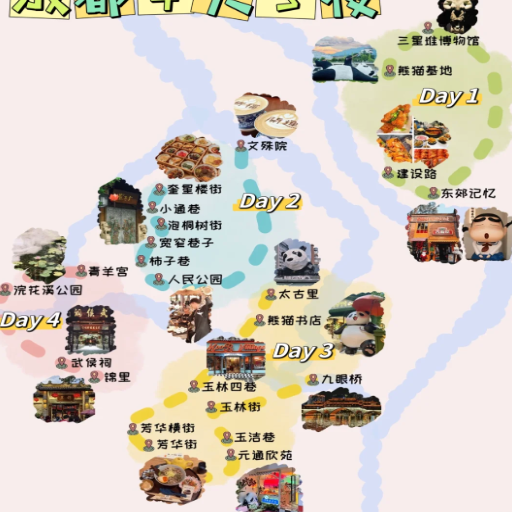Here, we share everything you need to know about Chengdu Panda Base, a dream come true for panda lovers. With astounding history and fascinating introductions regarding the purpose and history of the panda base, bear lovers will have their hearts exploding with so much joy. Aside from that, we delve into how you can make the most of your visit, such as understanding the best months for traveling, must-visit areas within the base, conservation efforts set to protect them, and, most importantly, getting tickets and transportation around the base and lastly, covering the most critical question of all. How can you make your panda adventure unforgettable? This guide features pro tips for animal lovers, family traveling, and panda-curious folks.
How to Get to the Chengdu Panda Base?

How to Get to the Chengdu Panda Base
Getting to the Chengdu Panda Base is easy and hassle-free. It is only 10 kilometers from the downtown area, which numerous transport systems can reach. A taxi ride from downtown takes around 30 minutes and costs about 30-50 RMB. Lines 198, 198A, and 655 public buses are also available, although these are slow and take longer. Anyone using Didi can get a ride without issues by writing “Chengdu Research Base of Giant Panda Breeding” in the app.
Best Ways to Travel from Downtown Chengdu
Should you be traveling from the downtown area to the Chengdu Research Base of Giant Panda Breeding, here are the most suitable choices accompanied by their specifications:
- Taxi or Ride-Hailing Apps
- Duration: Approximately 30-40 minutes, depending on traffic.
- Cost: A standard taxi costs 30-50 RMB. The costs of ride-hailing services like Didi will vary according to demand.
- Convenience: High; direct and comfortable.
- Public Bus
- Bus Lines: Line 198, Line 198A, or Line 655.
- Duration: Roughly 1-1.5 hours, depending on traffic situations and waiting times.
- Cost: Typically 2 RMB per trip.
- Convenience: Low; with little knowledge of the local area, it requires a little getting used to.
- Private Car or Tour Service
- Duration: 30-40 minutes.
- Cost: The price will vary depending on the service provider’s pocket, but it is usually higher than taxi services.
- Convenience: Great; includes pickup and drop-off services
Opt for a transportation method that meets your personal or business budget, scheduling, and comfort preferences.
Transportation Options to Panda Base
Panda Base can be easily reached using different modes of transport with unique advantages and disadvantages. Here is the breakdown based on reliability, convenience, and efficiency:
- By Taxi
- Duration: Approximately 30-40 minutes, depending on traffic conditions.
- Cost: Typically ranges between 30-50 RMB.
- Convenience: Very high. Taxis go directly to the Panda Base from your location. For extra safety, remember to use official taxis or Didi.
- By Public Bus
- Duration: Approximately 1-1.5 hours, depending on your starting location and bus route.
- Cost: Very economical, usually around 2 RMB per trip.
- Convenience: This option requires familiarity with local routes, making it potentially very low for tourists. Buses that serve the Panda Base include 87, 198, and 655, but look for buses to the Xiongmao Jidi stop.
- By Metro and Shuttle Bus
- Duration: Around 1 hour.
- Cost: The metro fare typically ranges from 2 to 6 RMB, and the shuttle fare is about 10 RMB.
- Convenience: Moderate. Take the Chengdu Metro to Panda Avenue station and then the Panda Base shuttle bus. This option offers the best balance of price and effectiveness.
- Private Car or Tour Service
- Duration: 30-40 minutes.
- Cost: Varies greatly, often 150-300 RMB, depending on the provider and package.
- Convenience: Very high. Usually includes direct hotel pick-up and drop-off, individual service, and optional guided tours. It is best for tourists who want comfort and flexibility.
- By Bicycle or Scooter
- Duration: Approximately 1 hour from the city center.
- Cost: Rental charges vary but are generally between 20-50 RMB for a half-day ride.
- Convenience: Moderate to high. This option offers moderate flexibility and is a greener way to navigate the city. It is recommended for skilled cyclists who can deal with city traffic.
When deciding on transport options, consider aspects such as your budget, how long you have, and how comfortable or convenient you want the experience to be. To minimize inconvenience during travel, plan your route and have any necessary tickets or apps ready for use if you travel by public transportation.
Tips for a Smooth Journey to Giant Panda Base
This is how you can prepare for the visit in advance, based on my experience and research:
- Arrive Early
The base tends to get busy a bit later in the day. I suggest getting there before 8 a.m. to avoid crowds so you can see the pandas during their active morning feeding time.
- Wear Comfortable Shoes
The base is quite big and includes a hilly area, which means more walking. Comfortable walking shoes are essential.
- Book Tickets in Advance
Ordering tickets online helps avoid long lines at the entrance. The standard entrance fee is generally around 55 CNY, but checking for the latest pricing and policies is advised.
- Plan for Transportation
The base is some 10 km from downtown Chengdu. For ease, you might want to take a taxi or car-hailing service, which usually costs around 30-50 CNY one way. Otherwise, the public buses Number 87 or Number 198 also stop near the entrance.
- Pack Essentials
Be sure to pack some light snacks to munch on, water, sunscreen, an umbrella for rain and sun, and food if you can. You can purchase food at the base, but it can be expensive.
- Respect the Guidelines
Flashing lights cannot be used to protect the pandas, and noise levels should not be loud. All on-site instructions should be followed to ensure a wonderful experience for all.
If you try to plan and follow the previously discussed tips, you will have a fabulous and unforgettable experience at the Giant Panda Base.
What Can You Expect at the Chengdu Panda Base?

What Can You Expect at the Chengdu Panda Base
At Chengdu Panda Base, guests will enjoy a close encounter with one of the animals everyone around the globe loves. From adults to cubs, Chengdu Panda Base is home to all kinds of pandas, making them available to be seen while they munch on their favorite food, bamboo, play, and even sleep. Some displays provide informative panda exhibitions related to conservation and breeding programs. Visitors from all around the globe can learn about the incredible wildlife and what is done to support it at the base where pandas reside, surrounded by lush nature.
Exploring the Panda Enclosures
The Panda Enclosures have been designed to ensure the pandas are comfortable and happy, which is pandemonium for a panda. A big space with lush bamboo-shaded resting areas and water features all construct such an environment. For the pandas’ health, the enclosures have temperature control systems set at a comfy range of 64°F to 77°F (18°C to 25°C) so they can have optimum health during all seasons. In addition, the design has climbing frames, swings, and feeding puzzles that allow for natural behaviors to be exhibited. Such efforts are being made to help this endangered species, as is true with all global zoos and conservation efforts.
Understanding the Panda Breeding Research Efforts
Research on breeding pandas is delicate work that helps solve the reproductive issues of these animals, whose numbers are dwindling. Breeders must deal with key factors like their short mating season—female pandas can only mate once per year for 24-72 hours—and low reproduction rate. Advanced methods like artificial insemination, genetic monitoring, and behavioral studies are used to address these factors to ensure reproduction.
Key Aspects and Practices in Panda Breeding Research:
- Breeding Season Monitoring:
- Female pandas are subjected to hormone or progesterone tracking and monitoring other indicators to help pinpoint their mating or estrus cycle.
- Ovulation, pregnancy, and other aspects are checked with thermal imaging and ultrasound.
- Artificial Insemination:
- To ensure the sperm can be used later, it is kept at around -196 degrees celcius in liquid nitrogen.
- Post-ovulation insemination is done in a 24 to 36-hour window, which has the highest chance of success.
- Caring for Cubs Post-Birth:
- Panda cubs are born at a very low weight, on average between 3-5 ounces, ensuring intensive care will allow them to survive.
- Temp-controlled sustainable indoor nurseries help protect at-risk newborns with a temperature range between 77 and 86 degrees Fahrenheit.
Genetic diversity measures underpin the conservation efforts mentioned above, as the gene pool needs to be active for genetic drift in long-term conservation. Genetic data control inbreeding pairs, ensuring the offspring are healthy. Moreover, creating networks between zoos and research centers worldwide has effectively helped share resources, information, and genetics.
As our species progresses towards the embodiment of science, breeding giant pandas helps save one of civilization’s traits. The programs mentioned are included in other policies on habitat restoration and general public education, so there will still be giant pandas in years to come.
Visit the Giant Panda Museum for Insights
I know that visiting the Giant Panda Museum is valuable in understanding this species’s conservation strategies and scientific advancements. The museum exhibits mainly focus on panda biology, breeding, and habitat preservation. Some famous facts include that giant pandas eat almost solely bamboo, have a controlled temperature range of 16ºC to 24ºC, and can only breed for a couple of days, 24-72 hours a year. In person, one can appreciate those efforts to conserve giant pandas and the international collaboration behind them.
When is the Best Time to Visit Chengdu and See Pandas?

When is the Best Time to Visit Chengdu and See Pandas
If you intend to see pandas, Chengdu is best visited from late August until November. The warm and mild weather makes this the best season to visit. The Chengdu Research Base of Giant Panda Breeding often has panda cubs born earlier in the year on display. Along with them, other pandas are also very active and playful at this time, making it easier for visitors to observe their natural behavior. It’s best to go in the morning to see them fed and more energetic.
Weather Considerations for Visiting Chengdu
Like the rest of China, Chengdu has a variety of climate zones. Summers can get very humid and warm from June to August, with an average of 25°-30° Celsius and periodic rainfall. Winters can get mildly damp and overcast, ranging from 5° to 10° Celsius. Due to the moderate temperature and low humidity, the spring and autumn months are the most pleasant and perfect for exploring the city.
Best Seasons to See Baby Pandas
The ideal time to witness baby pandas in all their glory is from August to October, during late summer and early autumn. This period is delightful as panda cubs born during June and August can be spotted and windowed – they are also engaging, active, and playful, making it a wonderful sight for spectators. To add to the experience, panda reserves like the Chengdu Research Base of Giant Panda Breeding should be visited as they offer a much clearer view, which, during these months, is highly recommended. Plan upfront so that tickets are reserved in advance, and to witness the pandas during their active hours, early morning visits should be planned to avoid crowds.
Can You Hold a Panda During Your Chengdu Panda Tour?

Can You Hold a Panda During Your Chengdu Panda Tour
When planning a tour to Chengdu, there may be chances to interact with pandas at some bases. The opportunity is minimal and exists at the Dujiangyan Panda base, though there are restrictions, such as booking and additional costs. Funds generated from the fees for these activities typically support panda conservation efforts. Lastly, check regularly, as policies are volatile and subject to change.
Guidelines for Interacting with Giant Pandas
- Maintain a Safe Distance
Once again, panda conservation is stringent, so if one wishes to view the animals, they must remain at a distance of 10 feet during supervised activities. This ensures the well-being of both the spectator and the panda.
- Follow the Instructions of the Staff
Each facility for the pandas has obvious instructions that must be followed for the safety and health of the pandas and other visitors.
- Do Not Feed the Pandas
To preserve the panda’s health, animal feeding should be strictly prohibited unless an authorized program allows someone to assist. A typical diet would include bamboo, fruit, and specialty supplements from knowledgeable professionals.
- Avoid Loud Noises and Sudden Movements
Like every sensitive animal, pandas do not like yelling, applause, or strange body movements toward them. Learning to control your volume is crucial if you expect to see any pandas.
- Sanitize Before Contact
The participant is put in protective clothing such as gloves and masks for program involvement that allows holding or touching onto a panda. These and thorough hand washing ensure that the panda is kept uncontaminated.
- Stay Within Designated Areas
The paths or zones made available to the public must be observed because leaving them can mean intruding on the pandas’ living area, and vice versa is dangerous.
- Photography Guidelines
Each person is allowed to take pictures of the pandas; however, flash is not allowed while taking the photos, as it will harass the pandas. Be creative; adjustable lighting offers endless possibilities.
Following these tips allows for a fulfilling visit while being mindful of how these unique animals are treated and preserved.
Understanding the Panda Conservation Efforts
Panda conservation aims to preserve the giant panda population and their natural habitats through habitat restoration, breeding programs, and conservation awareness campaigns. This also includes the establishment of many protected reserves and helping to reforest bamboo forests, which are an essential part of the panda’s diet. A critical component of captive breeding programs is the genetic diversity of the resulting offspring. In general, breeding facilities employ advanced veterinary medicine and genetic monitoring to track their charges’ health and reproductive cycles, ensuring success rates continually improve. Additionally, sustaining these programs and preventing extinction requires public funding, education, and enforced policies regulating deforestation.
What Other Attractions are Near the Panda Research Base?

What Other Attractions are Near the Panda Research Base
Besides the Panda Research Base, people can visit other important sites, such as the People’s Park, which has charming scenery and tea establishments. Tourists can also explore the heart of Chengdu, Jinli Ancient Street, where they can buy local souvenirs and taste authentic Sichuan food. Shoutout to Mount Qingcheng, a UNESCO World Heritage site near Chengdu highly regarded for its Taoist culture. It also offers scenic hikes in the surrounding region. Another popular sight is the Chengdu Research Base of Giant Panda Breeding, well-known for its gardens and peaceful walking paths. Nearby Wenshu Monastery is also a refraining place while showcasing traditional Buddhist architecture.
Exploring Chengdu City and Its Other Highlights
The capital city of Sichuan Province is Chengdu, famous for its modern lifestyle, rich culture, and artistic pursuits. Chengdu is packed with sights and sounds because it blends modern and age-old architectural wonder.
History buffs will appreciate the Jinsha Site Museum’s remarkable relics and artifacts, which tell the story of the Shu Kingdom civilization. Art lovers will surely enjoy the Sichuan Museum, which has thousands of pieces, from calligraphy to ceramic masterpieces.
Furthermore, travel times between essential landmarks and their accessibility make planning quite simple. Some examples would be:
- Distance from Panda Research Base to Wenshu Monastery: ~10 miles (16 km)
- Distance from Panda Research Base to Jinli Ancient Street: ~11 miles (18 km)
- Average time to visit major attractions:
- Chengdu Research Base of Giant Panda Breeding: ~2-3 hours
- Wenshu Monastery or Jinli Ancient Street: ~1-2 hours each
Chengdu’s efficient public transport, including buses and metro lines, makes traveling within the city very convenient. This makes Chengdu an ideal hub for tourism in the Southwest region of China.
Visit the Dujiangyan Panda Base
The Dujiangyan Panda Base is 34 miles (55 km) outside Chengdu. As a giant panda conservation center, their primary focus is rescuing, rehabilitating, and returning pandas to their natural habitat. Guests can join the Panda Keeper Program, where they can help care for pandas and learn about the various conservation projects of the base. Visitors can also immerse themselves in spectacular panda enclosures.
Key Information:
- Distance from Chengdu: ~34 miles (55 km)
- Travel Time by Car: ~1-1.5 hours depending on traffic
- Opening Hours: 8:30 AM – 5:30 PM (last entry at 4:30 PM)
- Entry Fee: ~60 CNY (varies by season and available activities)
- Time Spent at the Base: ~3-4 hours on average for a comprehensive visit
Besides the pleasant nature of Mount Qingcheng’s foothills, the amazing guided tours aim to educate guests on the multifaceted issues relating to panda breeding and habitat conservation. The panda base is also near other attractions, including world heritage sites like the Dujiangyan Irrigation system.
Experience the Natural Habitat of Pandas in Sichuan
It’s remarkable to think about visiting a Panda’s Sichuan habitat; I would love to go! Like the Dujiangyan Panda Base, Panda Bases lets you learn about panda conservation while seeing these incredible animals up close. The excellent staff walks you through all that goes into their preservation efforts, such as breeding and more complex science rehabilitation programs.
Here are some key details to consider for your visit:
- Primary Location: Dujiangyan Panda Base or Bifengxia Panda Base
- Travel Time from Chengdu: ~1-1.5 hours for Dujiangyan; ~2 hours for Bifengxia
- Opening Hours: 8:30 AM – 5:00 PM (depending on the base)
- Entry Fee: ~60-100 CNY, with extra fees for interactive programs like panda hugging or feeding (~700-1,500 CNY)
- Best Time to Visit: Early morning for active pandas
- Time Spent on Site: ~3-5 hours
Expect to enjoy picturesque landscapes and gain a greater understanding of these amazing creatures and the attempts being made to conserve them. Thankful, from guided tours to active experiences, there surely is something for everyone to enjoy.
References
Wolong National Nature Reserve
Frequently Asked Questions (FAQ)
Q: What is the best time to see giant pandas at the Chengdu Panda Base?
A: The best time to see giant pandas is in the morning, especially between 8:30 AM and 10:00 AM, when they are most active during feeding. Visiting early also helps to avoid large crowds.
Q: How can I get to the Chengdu Panda Base from downtown Chengdu?
A: You can get to the Chengdu Panda Base by taking a taxi, which takes about 30 minutes from downtown. Alternatively, you can take Line 3 of the Chengdu Metro to Panda Avenue Station and then a bus or taxi ride to the base.
Q: Can I visit the Chengdu Panda Base without a tour guide?
A: You can visit the Chengdu Panda Base without a tour guide. The base is well-signposted, and maps are available to help you navigate the facility independently.
Q: What is the Chengdu Research Base of Giant Panda Breeding?
A: The Chengdu Research Base of Giant Panda Breeding is a world-class research facility dedicated to conserving and breeding giant pandas. It also aims to educate the public about panda conservation efforts.
Q: Are there red pandas at the Chengdu Panda Base?
A: Yes, the Chengdu Panda Base is home to giant and red pandas. These little pandas can be found in their dedicated areas within the base.
Q: What other attractions are there at the Chengdu Panda Base?
A: Besides panda viewing, the base offers an education center, a panda museum, and several scenic walking paths. Visitors can also see swans and other animals in the park-like setting.
Q: How much time should I allocate to visit the Chengdu Panda Base?
A: It is recommended to allocate at least 2-3 hours for a visit to thoroughly enjoy the panda viewing experience and explore the other attractions at the base.
Q: Are there any places to see pandas near Chengdu besides the Panda Base?
A: Other places to see pandas near Chengdu include the Wolong Panda Reserve and the Dujiangyan Panda Base, both offering unique panda-viewing experiences.
Q: Can panda babies be seen at the Chengdu Panda Base?
A: Yes, visitors to the Chengdu Panda Base often have the chance to see panda babies, especially during the breeding season from August to September.
Q: Can I purchase panda-related souvenirs at the Chengdu Panda Base?
A: Yes, there is a gift shop at the base where you can buy panda toys, clothing, and other memorabilia to remember your visit.